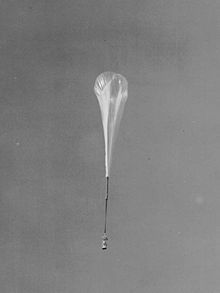
Stratoscope
Encyclopedia

Balloon
A balloon is an inflatable flexible bag filled with a gas, such as helium, hydrogen, nitrous oxide, oxygen, or air. Modern balloons can be made from materials such as rubber, latex, polychloroprene, or a nylon fabric, while some early balloons were made of dried animal bladders, such as the pig...
-borne astronomical telescope
Telescope
A telescope is an instrument that aids in the observation of remote objects by collecting electromagnetic radiation . The first known practical telescopes were invented in the Netherlands at the beginning of the 1600s , using glass lenses...
s which flew from the 1950s to the 1970s and observed in the optical and infrared
Infrared
Infrared light is electromagnetic radiation with a wavelength longer than that of visible light, measured from the nominal edge of visible red light at 0.74 micrometres , and extending conventionally to 300 µm...
regions of the spectrum. Both were controlled remotely from the ground.
Stratoscope I possessed a 12 inch (30.48 cm) mirror and was first flown in 1957. It was conceived by Martin Schwarzschild
Martin Schwarzschild
Martin Schwarzschild was a German American astronomer. He was the son of famed astrophysicist Karl Schwarzschild and the nephew of the Swiss astrophysicist Robert Emden.-Biography:...
and built by the Perkin Elmer Corporation
PerkinElmer
PerkinElmer, Inc. is an American multinational technology corporation, focused in the business areas of human and environmental health, including environmental analysis, food and consumer product safety, medical imaging, drug discovery, diagnostics, biotechnology, industrial applications, and life...
. A small secondary mirror focussed the image from the primary into a 35 mm movie camera, which captured the images on film. Schwarzschild used the telescope to study the turbulence and granulation
Granule (solar physics)
Granules on the photosphere of the Sun are caused by convection currents of plasma within the Sun's convective zone. The grainy appearance of the solar photosphere is produced by the tops of these convective cells and is called granulation.The rising part of the granules is located in the center...
in the Sun
Sun
The Sun is the star at the center of the Solar System. It is almost perfectly spherical and consists of hot plasma interwoven with magnetic fields...
's photosphere
Photosphere
The photosphere of an astronomical object is the region from which externally received light originates. The term itself is derived from Ancient Greek roots, φῶς, φωτός/phos, photos meaning "light" and σφαῖρα/sphaira meaning "sphere", in reference to the fact that it is a spheric surface perceived...
.
Stratoscope II, a 36 inch (91.4 cm) reflecting telescope, flew from 1963 to 1971. The gondola it was mounted on weighed 3.5 tons. It studied planetary atmospheres, the atmospheres of red giant
Red giant
A red giant is a luminous giant star of low or intermediate mass in a late phase of stellar evolution. The outer atmosphere is inflated and tenuous, making the radius immense and the surface temperature low, somewhere from 5,000 K and lower...
stars, and galaxies
Galaxy
A galaxy is a massive, gravitationally bound system that consists of stars and stellar remnants, an interstellar medium of gas and dust, and an important but poorly understood component tentatively dubbed dark matter. The word galaxy is derived from the Greek galaxias , literally "milky", a...
. On early flights of Stratoscope II, photographic film was used, but this was soon replaced by television detectors.

